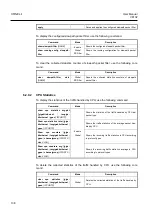
UMN:CLI
User Manual
V8102
152
snmp trap pps-control
Configures the system to send SNMP trap when the
number of packets per second exceeds or falls below
the PPS threshold.
snmp trap temp-threshold
Configures the system to send SNMP trap when sys-
tem temperature exceeds or falls below the threshold.
7.1.10.4
Disabling SNMP Trap
To disable the SNMP trap, use the following command.
Command
Mode
Description
no snmp trap
{
auth-fail
|
cli-history
|
cold-start
|
cpu-threshold
|
detect-rogue-onu
|
link-
threshold
|
linkstatus
|
mem-threshold
|
onu-
broadcast-storm
|
onu-crc-error
|
onu-line-
code-error
|
system-restart
|
cpu-threshold
|
temp-threshold
|
dhcp-lease
|
fan
|
power
|
pps-
control
|
module
}
Global
Disables each SNMP trap.
7.1.10.5
Displaying SNMP Trap
To display the configuration of the SNMP trap, use the following command.
Command
Mode
Description
show snmp trap
Enable
Global
Shows the configuration of SNMP trap.
show snmp alarm-report
Shows a collected alarm report based trap.
7.1.11
SNMP Alarm
The V8102 provides an alarm notification function. The alarm will be sent to a SNMP trap
host whenever a specific event in the system occurs through CLI. You can also set the
alarm severity on each alarm and make the alarm be shown only in case of selected se-
verity or higher. This enhanced alarm notification allows system administrators to manage
the system efficiently.
7.1.11.1
Alarm Notify Activity
Normally the V8102 is supposed to generate an alarm only when a pre-defined event has
occurred such as the fan fail, system restart, temperature high, etc. However, you can
additionally configure the system to generate an alarm when any configuration parameter
has been changed via CLI.
To enable/disable the alarm notify activity, use the following command.
Command
Mode
Description
snmp notify-activity
{
enable
|
disable
}
Global
Enables/disables the alarm notify activity.
(default: disable)














































